This is the 66th in a series of posts on the Fujifilm GFX-50S. The series starts here.
In this post, I reported on Fuji GFX 50S systematic autofocus errors at certain f-stops (mostly one, actually) using the 23 mm f/4 lens. I have seen similar behavior with the 63 and 120 macro. When I made the photographs for yesterday’s visual comarison of the 110 on the GFX and teh Otus 85 on the Sony a7RII, I shot some AF pix with the GFX just to see what would happen. In all cases, at least one one of my manually focussed images was sharper. At f/2.8, the manually focused ones were a lot sharper.
Thus, it was with some trepidation that I set up my controlled af test. I used the following low-contrast target:
I have marked the region of interest that I used in red. Here’s the procedure:
- ISO 100
- AF-S
- Spot and Zone both tested (this is new; I just tested spot before)
- Spot set on the ROI, which included a bit of the zone plate.
- Zone set the same plate which included all the zone plate and some or all of several squares.
- Release priority: focus
- Pre-trigger: 500 milliseconds, which was long enough for focus confirmation green square to flash and confirmation beep to sound in all cases
- Manual exposure
- Wescott LED panels set to 5500 K.
- Electronic shutter
- Cognisys computer-driven focusing rail
- 32 exposures 4 mm apart
- Target distance at the center of the rial, 3 m.
- RAF converted to DNG in Adobe DNG Converter
- DNG exported as TIFF mosaiced file in dcraw (document mode)
- TIFFs cropped and raw channels selected in Matlab program
- MTF50 of cropped TIFFs measured with MTF Mapper
- Data assembled in Matlab
- Data plotted in Excel
The spot mode data for the red and blue raw channels, and the Gr one:
What you are looking at is a standard measure of sharpness, MTF50, as measured in cycles per picture height (cy/ph) at the whole stops from f/2 through f/11. The orange line is the average, or mean, of the 32 exposures at each aperture. The gray line is that average, plus the standard deviation for the 32 exposures, and the blue line is the average minus that standard deviation. If the data were Gaussian (which it isn’t) two thirds of the values would be between the gray and the blue lines.
For comparison, here’s a run of 100 images 1.6 cm apart with the focus fixed using MF at f/2.8, the sharpest aperture for this lens, and the one that seems to give the AF algorithm the most trouble:
You can see that peak sharpness is about 1400 cy/ph. This is much lower than we get with the high contrast target, but we’re just interested in relative sharpness here. The average sharpness using AF at f/2.8 is less than that, but not by much. Focusing at f/2.8 is not very consistent, though. AF is pretty consistent at the other apertures. This is the best AF performance I’ve seen in hte four lenses tested.
Now let’s look at the results in zone Ad MODE:
At f/2.8, the AF performance is much more consistent, and the results are very close to the best you could do focusing manually.
This means that I’m going to have to go back and run the other three lenses through the same tests in zone mode.
Note that the blue channel, which was weak at f/2 in the manual focusing tests using the razor blade target, is fine here. I’m not sure what that’s about.
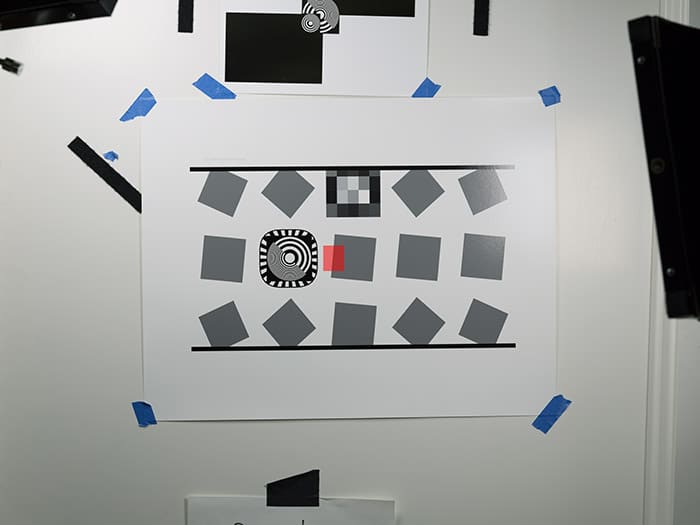
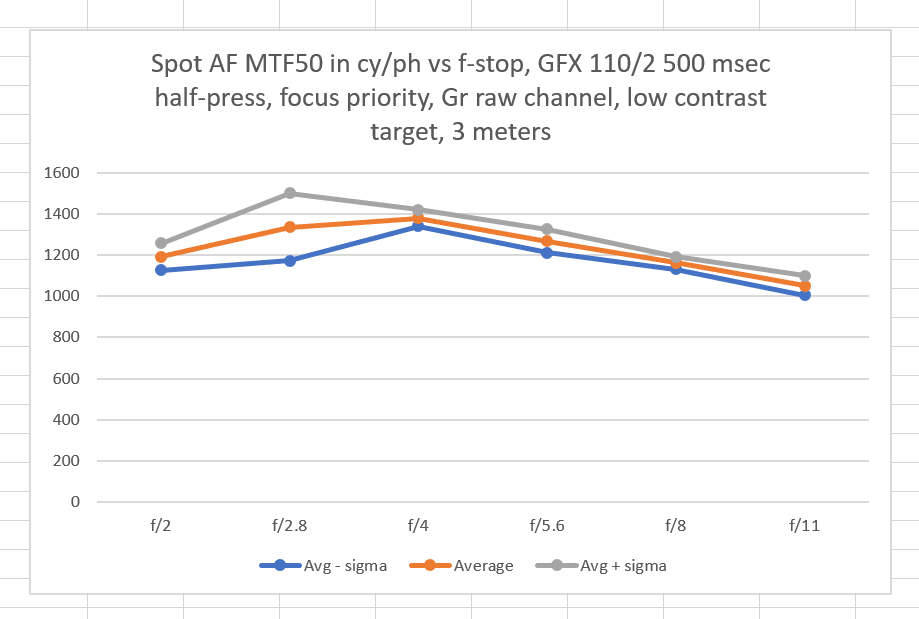

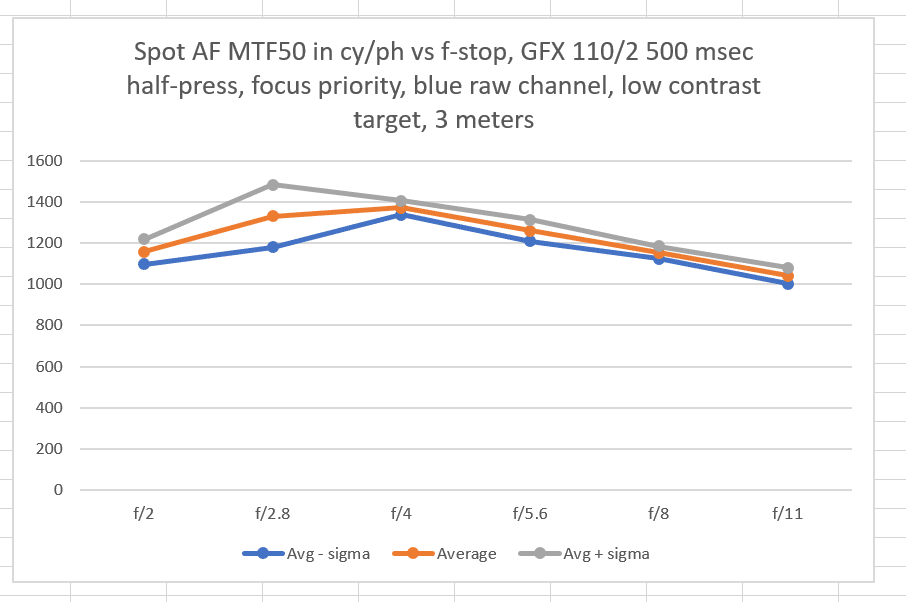
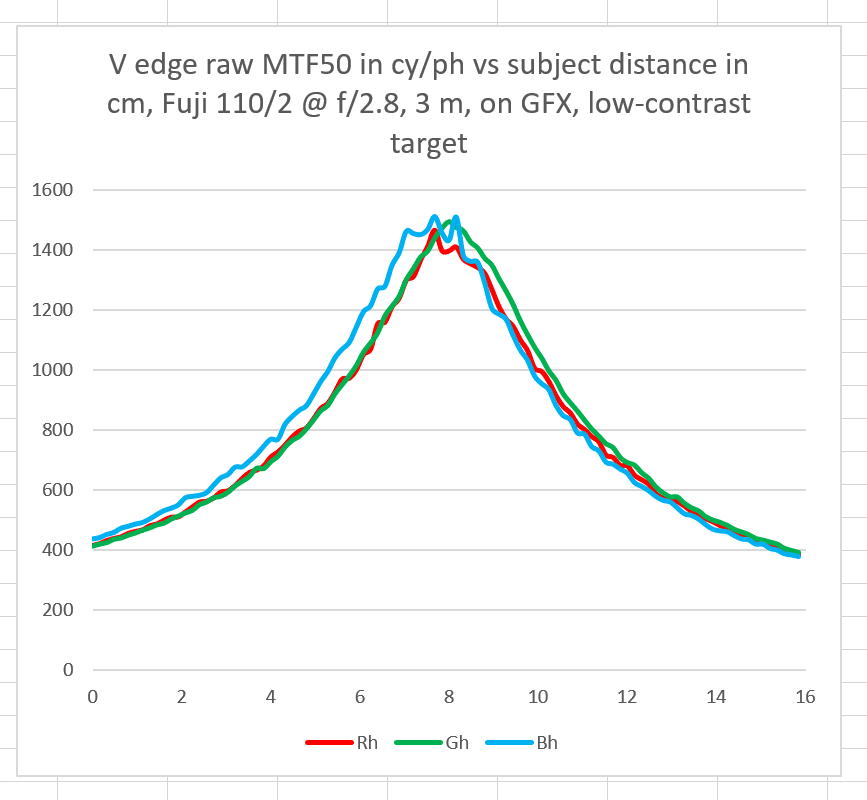
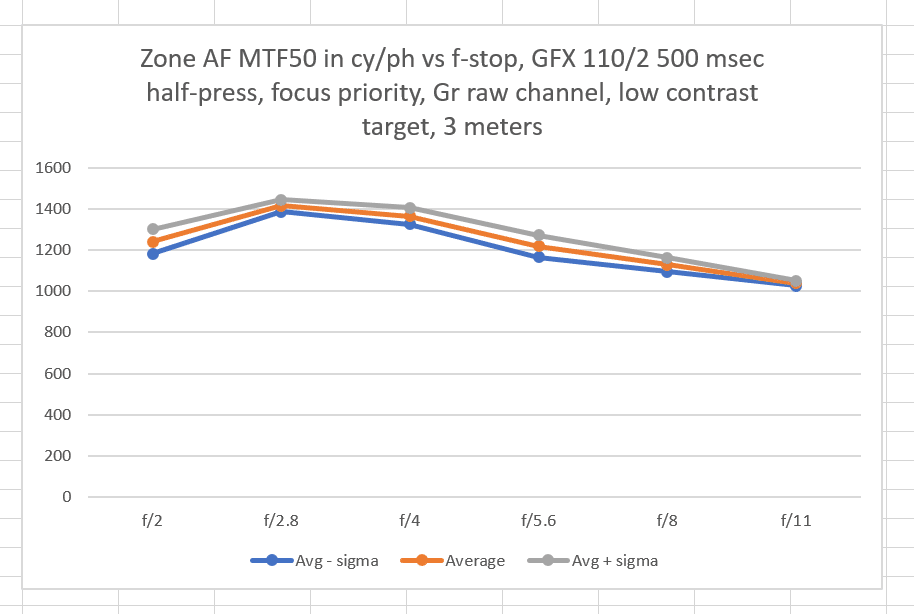
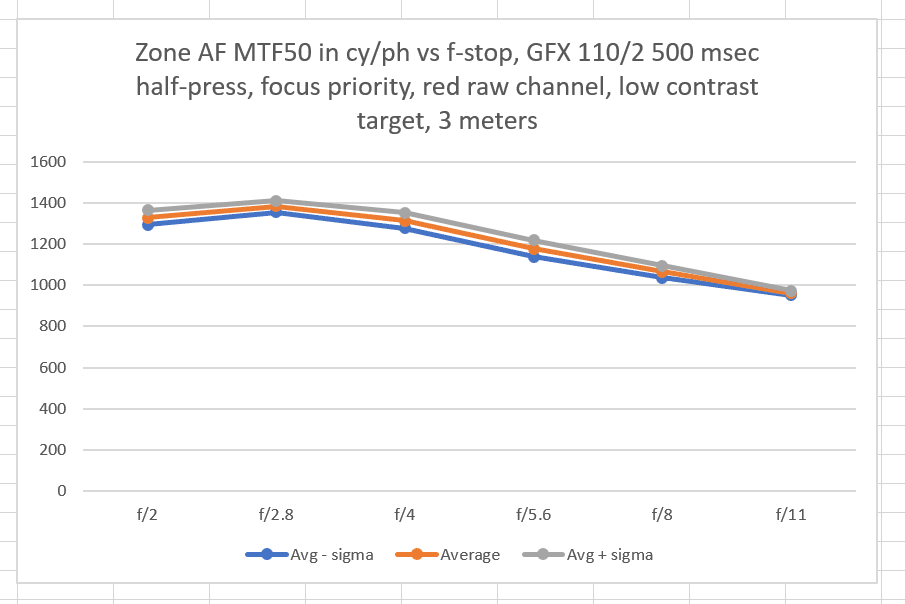
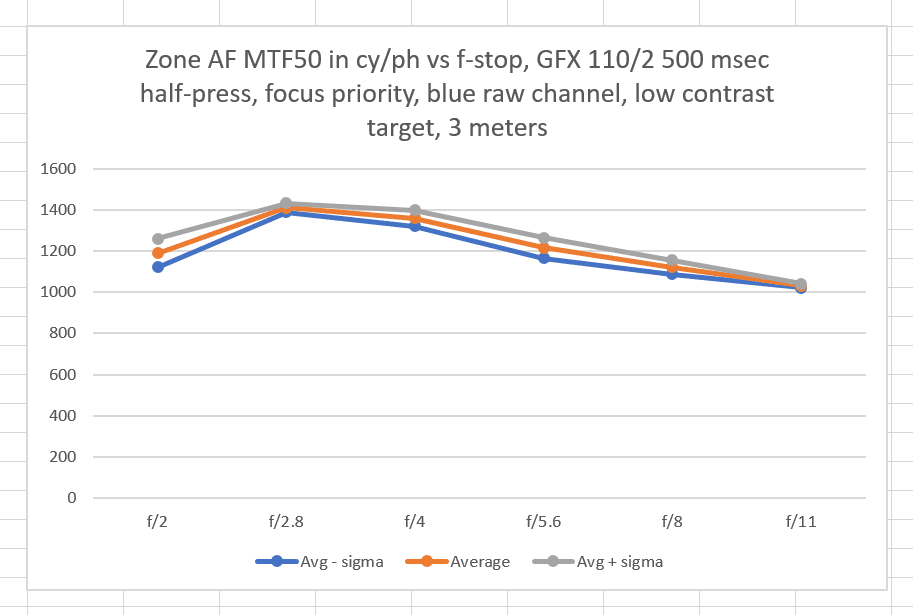
Why does the contrast of the chart have such an impact on the MTF? If the chart is sufficiently sharply printed, the global contrast should be normalized out and not impact the measurement.
It’s not just the contrast; it’s the edge sharpness. The low contrast chart is printed. The high contrast chart is a physical razor blade.
Ah, so the answer to “if the chart is sufficiently sharply printed…” is that an injet print limits the test. Thanks
Yes. That is demonstrated to me by the fact that the MTFs go up as I back away from the printed target, and don’t with the razor blade.
Ah, interesting insight.
The blue channel isn’t actually better here, it’s just not much worse than it was on the high-contrast edge. The other colors are significantly weaker, though.
Good point. However, I don’t think that explains with relative differences, since blur sources tend to add as the square root of the sum of the squares. If it wre just the sharpness of the edge, I’d expect to see more difference in the channel MTF50s with the printed target.
Hi Jim,
Is there a difference in the length of the edge extracted from the low-contrast target, and the length of the edge extracted from the razor blade?
My rule of thumb is to aim for an edge length of 80 pixels. When using –bayer green, you would have to double the edge length, and in –bayer red and –bayer blue, quadruple the edge length (320 pixels!) to maintain the number of individual samples used by the slanted edge method. In practice, you can probably get away with somewhat shorter edges, but that depends on the overall SNR (across the edge).
Anyhow, a large difference in edge length could explain the observed difference in the blue channel performance.
For both the printed target and the razor blade, I have been using 200×200 pixel crops in the GFX lens tests. The exception is the 23mm lens, where I didn’t want to get close enough to get the razor blade big enough in the image for a 200×200 crop, so I used 100×100. The 200×200 crop gives 100×100 in each raw plane. The 100×100 crop gives 50×50, which is below your standards, and probably explains the noise in the resultant data.
Thanks for stopping by Frans, and for all your help. The new version of MTF Mapper is working perfectly for me.
Hi;
I am a gfx user and having focus shift and focus inconsistency problems with 120mm f4 especially at f5.6.Do you think zone focusing can solve this problem instead of using single point?Single point is always adviced for better af but i am confused.
By the way will you make a comparrison at landscape distance of 120mm and 110mm ?I really wonder if 110mm is sharper than 120mm let’s say at f4 to f11.
Thank You
I’ll look at doing the 110/120 test. It will have to be a visual, qualitative, test. I have no way of doing quantitative tests at great distances.
I haven’t tested the 120 with zone focusing yet, but it certainly had a problem for me at f/5.6 with spot focusing.
It will be great to see which is sharper at your visual test.
From the writing i tought that you said 120mm is focusing more consistently with zone focusing ?
You are right. I had forgotten that I did that test. Note, though, that it seems to be target dependent. The f/5.6 values in the zone vs spot test weren’t as bad as in the first spot test that I did a couple of month ago.
I am speaking with Fuji lens design team in Japan about the focus shift issue.What they have told me is they measured the focus shift in different distances and fine tuned it by the last firmware.But when shared them my findings after firmware update they did not understand the problem so they started to measure the lens again.I will let you know their findings.
Please let us know if you get some more info form the Fuji lens design team. I am also curious if they will further improve focus shift and AF performance with the upcoming FW 2.0.
Sad to say, but the Fuji designers don’t have me on their contact list.